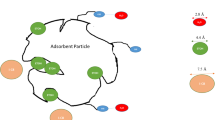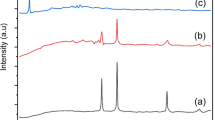Abstract
Bioethanol is considered a potential liquid fuel that can be produced from biomass by fermentation and distillation. Although most of the water is removed by distillation, the purity of ethanol is limited to 95–96 % due to the formation of a low-boiling point, water–ethanol azeotrope. To improve the use of ethanol as a fuel, many methods, such as dehydration, have been proposed to avoid distillation and improve the energy efficiency of extraction. Glucose-based silica, as an adsorbent, was prepared using a simple method, and was proposed for the adsorption of water from water–ethanol mixtures. After adsorption using 0.4 g of adsorbent for 3 h, the initial water concentration of 20 % (water, v/v) was decreased to 10 % (water, v/v). For water concentrations less than 5 % (water, v/v), the adsorbent could concentrate ethanol to 99 % (ethanol, v/v). The Langmuir isotherms used to describe the adsorption of water on an adsorbent showed a correlation coefficient of 0.94. The separation factor of the adsorbent also decreased with decreasing concentration of water in solution.











Similar content being viewed by others
References
Quintero, J. A., Montoy, M. I., Sánchez, O. J., Giraldo, O. H., & Cardona, C. A. (2008). Fuel ethanol production from sugarcane and corn: comparative analysis for a Colombian case. Energy, 33, 385–399.
Gnansounou, E., & Dauriat, A. (2010). Techno-economic analysis of lignocellulosic ethanol: a review. Bioresource Technology, 101, 4980–4991.
Bridgwater, A. V. (1995). The technical and economic feasibility of biomass gasification for power generation. Fuel, 74, 631–653.
Qureshi, N., Hughes, S., Maddox, I. S., & Cotta, M. A. (2005). Energy-efficient recovery of butanol from model solutions and fermentation broth by adsorption. Bioprocess and Biosystems Engineering, 27, 215–222.
Vane, L. M. (2005). A review of pervaporation for product recovery from biomass fermentation processes. Journal of Chemical Technology and Biotechnology, 80, 603–629.
Dias, M. O. S., Ensinas, A. V., Nebra, S. A., Filho, R. M., Rossell, C. E. V., & Maciel, M. R. W. (2009). Production of bioethanol and other bio-based materials from sugarcane bagasse: integration to conventional bioethanol production process. Chemical Engineering Research and Design, 87, 1206–1216.
Garcia-Herreros, P., Gomez, J. M., Gil, I. D., & Rodriguez, G. (2011). Optimization of the design and operation of an extractive distillation system for the production of fuel grade ethanol using glycerol as entrainer. Industrial and Engineering Chemistry Research, 50, 3977–3985.
Alpert, A. J. (1990). Hydrophilic-interaction chromatography for the separation of peptides, nucleic acids and other polar compounds. Journal of Chromatography, 499, 177–196.
Hemström, P., & Irgum, K. (2006). Hydrophilic interaction chromatography. Journal of Separation Science, 29, 1784–1821.
Enomoto, N., Furukawa, S., Ogasawara, Y., Akano, H., Kawamura, Y., Yashima, E., et al. (1996). Preparation of silica gel-bonded amylose through enzyme-catalyzed polymerization and chiral recognition ability of its phenylcarbamate derivative in HPLC. Analytical Chemistry, 68, 2798–2804.
Kacprzak, K. M., Maier, N. M., & Lindner, W. (2006). Highly efficient immobilization of Cinchona alkaloid derivatives to silica gel via click chemistry. Tetrahedron Letters, 47, 8721–8726.
Moni, L., Ciogli, A., D’Acquarica, I., Dondoni, A., Gasparrini, F., & Marra, A. (2010). Synthesis of sugar-based silica gels by copper-catalysed azide–alkyne cycloaddition via a single-step azido-activated silica intermediate and the use of the gels in hydrophilic interaction chromatography. Chemistry—A European Journal, 16, 5712–5722.
Kobayashi, K., Sumitomo, H., & Ina, Y. (1985). Synthesis and functions of polystyrene derivatives having pendant oligosaccharides. Polymer Journal, 17, 567–575.
Hamshimoto, K., Imanishi, S., Okada, M., & Sumitomo, H. (1991). Chemical modification of the reducing chain end in dextrans and trimethylsilylation of its hydroxyl groups. Journal of Polymer Science Part A: Polymer Chemistry, 29, 1271–1279.
Haupt, M., Knaus, S., Rohr, T., & Gruber, H. (2000). Carbohydrate modified polydimethylsiloxanes. Part 1. Synthesis and characterization of carbohydrate silane and siloxane building blocks. Journal of Macromolecular Science: Pure and Applied Chemistry, A37, 323–341.
Chen, Y., Zhang, Z., Sui, X., Brennan, J. D., & Brook, M. A. (2005). Reduced shrinkage of sol–gel derived silica using sugar-based silsesquioxane precursors. Journal of Materials Chemistry, 15, 3132–3141.
Bayazit, S. S., Inci, I., & Uslu, H. (2011). Adsorption of lactic acid from model fermentation broth onto activated carbon and Amberlite IRA-67. Journal of Chemical & Engineering Data, 56, 1751–1754.
Tian, M., Bi, W., & Row, K. H. (2011). Molecular imprinting in ionic liquid-modified porous polymer for recognitive separation of three tanshinones from Salvia miltiorrhiza Bunge. Analytical and Bioanalytical Chemistry, 399, 2495–2502.
Bi, W., Zhou, J., & Row, K. H. (2011). Solid phase extraction of lactic acid from fermentation broth by anion-exchangeable silica confined ionic liquids. Talanta, 83, 974–979.
Carleton, N. R., & Robert, W. S. (1966). Adsorption separation factors and selective adsorbent capacities of some binary liquid hydrocarbon mixtures. Journal of Physical Chemistry, 70, 787–797.
Coughlin, R. W., & Ezra, F. S. (1968). Role of surface acidity in the adsorption of organic pollutants on the surface of carbon. Environmental Science & Technology, 2, 291–297.
Al-Degs, Y., Khraisheh, M. A. M., Allen, S. J., & Ahmad, M. N. (2000). Effect of carbon surface chemistry on the removal of reactive dyes from textile effluent. Water Research, 34, 927–935.
Kuhn, J., Yajima, K., Tomita, T., Gross, J., & Kapteijn, F. (2008). Dehydration performance of a hydrophobic DD3R zeolite membrane. Journal of Membrane Science, 321, 344–349.
Acknowledgments
This research was supported by an INHA University Research Grant (INHA-2013).
Author information
Authors and Affiliations
Corresponding author
Rights and permissions
About this article
Cite this article
Tang, B., Bi, W. & Row, K.H. Dehydration of Ethanol by Facile Synthesized Glucose-Based Silica. Appl Biochem Biotechnol 169, 1056–1068 (2013). https://doi.org/10.1007/s12010-012-0076-z
Received:
Accepted:
Published:
Issue Date:
DOI: https://doi.org/10.1007/s12010-012-0076-z




